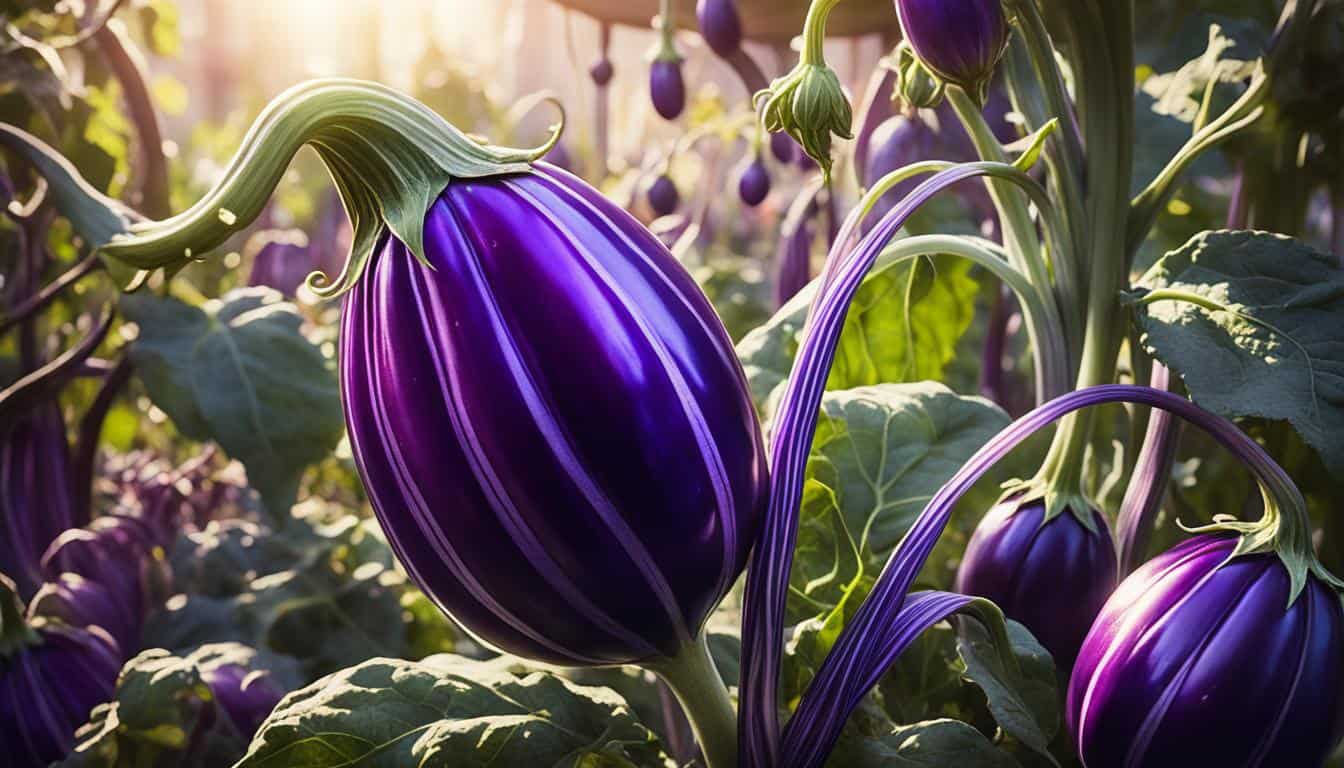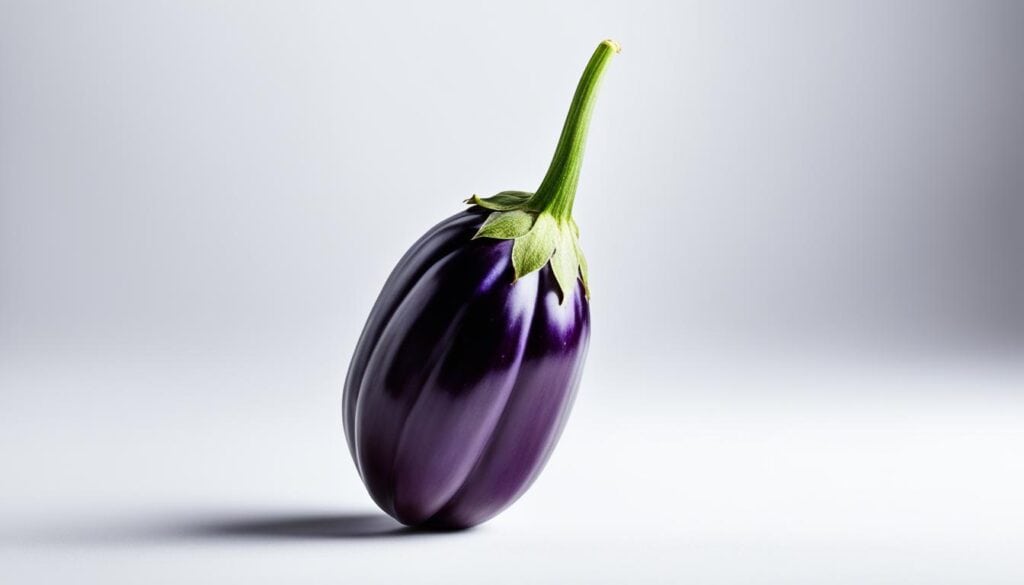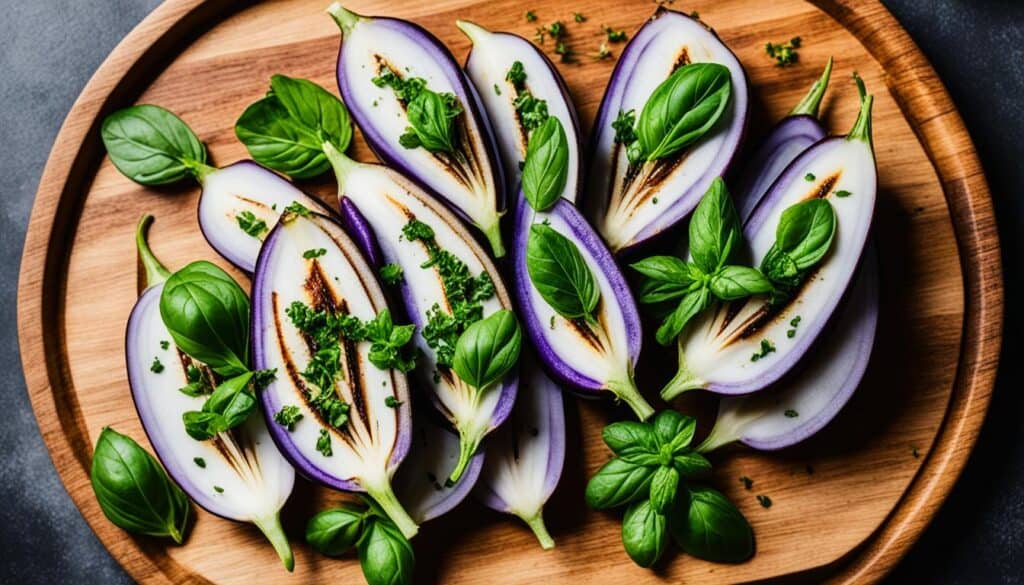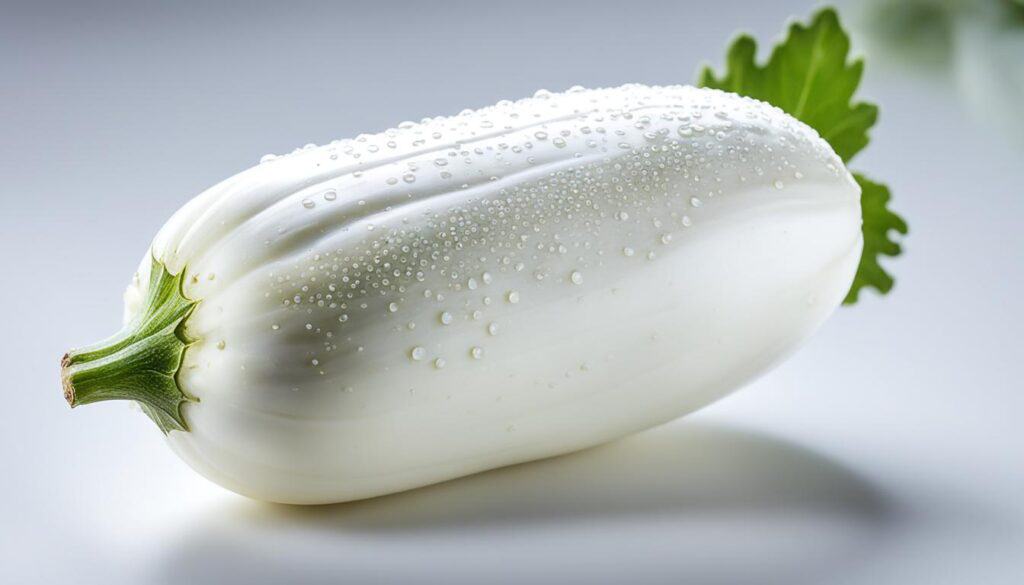Did you know that there are numerous types of eggplants available, each with its own distinct flavor and characteristics? From the globe (or American) eggplant to the fairy tale eggplant, the world of eggplant cultivars is diverse and exciting. Let’s dive into the different types of eggplant and uncover the unique qualities they bring to the table.
Key Takeaways:
- There are several main types of eggplant, including globe, Chinese, fairy tale, Italian, Japanese, graffiti, green Thai, Filipino, white, and Rosa Bianca eggplant.
- Eggplants are versatile and can be cooked in various ways, such as grilling, frying, roasting, or baking.
- Each type of eggplant has its own unique flavor and texture, allowing for a wide range of culinary possibilities.
- Exploring different eggplant varieties can add excitement and diversity to your dishes.
- Choose the right eggplant variety based on your desired cooking method and flavor profile.
Globe (American) Eggplant
Globe eggplants, also known as American eggplants, are large and deep purple in color. They are commonly found in grocery stores year-round and are versatile in cooking. They can be roasted, grilled, fried, or baked, and are often used in dishes like eggplant Parmesan and fried eggplant.
One of the most popular dishes featuring globe eggplant is eggplant Parmesan. This classic Italian recipe layers slices of roasted or fried eggplant with tomato sauce, cheese, and herbs, creating a delicious and satisfying meal.
Another tasty way to enjoy globe eggplant is by frying it. The crispy exterior and creamy interior make for a delightful combination of flavors and textures. Whether dipped in batter or breaded and seasoned, fried eggplant is a crowd-pleaser.
Versatile Cooking Methods
Globe eggplants lend themselves well to various cooking methods, allowing you to experiment and create a wide range of dishes. Here are a few popular ways to prepare them:
- Roasting: Slice the eggplant, drizzle with olive oil, season with salt and pepper, and roast in the oven until tender.
- Grilling: Brush the eggplant slices with oil, grill until charred and smoky, and serve as a side dish or in sandwiches.
- Frying: Dip eggplant slices in batter or bread crumbs and deep-fry until golden and crisp.
- Baking: Cut the eggplant into rounds or lengthwise slices, brush with olive oil, and bake until soft and browned.
Globe eggplants are a versatile ingredient that can elevate your culinary creations. Their robust flavor and meaty texture make them a favorite among chefs and home cooks alike.
“Globe eggplants are not only delicious but also a healthy addition to your diet. They are low in calories and high in fiber, antioxidants, and vitamins. Adding eggplant to your meals can help promote overall health and well-being.”
| Preparation Method | Flavor Profile |
|---|---|
| Roasted | Rich and smoky |
| Grilled | Charred and savory |
| Fried | Crispy and indulgent |
| Baked | Tender and succulent |
Explore the culinary possibilities with globe eggplant and enjoy the delicious flavors it brings to your table.
Fairy Tale Eggplant
When it comes to eggplants, size doesn’t always matter. Enter fairy tale eggplants, the petite darlings of the eggplant world. These small eggplants are known for their vibrant white stripes that adorn their deep purple skin, adding a whimsical touch to their appearance.
Despite their small size, fairy tale eggplants pack a delightful flavor punch. They have a mild and sweet taste that is loved by many. The tender flesh of these eggplants makes them perfect for grilling or roasting, bringing out their natural flavors and creating a deliciously caramelized exterior.
These small wonders are often used as appetizers or side dishes in various cuisines. Their compact size makes them ideal for individual servings or as a colorful addition to vegetable platters. Incorporating fairy tale eggplants into your meals will not only enhance the visual appeal but also add a burst of flavor.
Curious to know more about the culinary potential of fairy tale eggplants? Check out the tantalizing recipe below:
“Grilled Fairy Tale Eggplants with Balsamic Glaze”
Ingredients:
- 1 pound fairy tale eggplants
- 2 tablespoons olive oil
- Salt and pepper to taste
- 2 tablespoons balsamic glaze
- Fresh herbs for garnish
Instructions:
- Preheat the grill to medium-high heat.
- Trim the ends of the fairy tale eggplants and slice them in half lengthwise.
- Brush the eggplant halves with olive oil and season with salt and pepper.
- Grill the eggplants for 3-4 minutes on each side, or until they are tender and slightly charred.
- Remove the grilled eggplants from the heat and drizzle them with balsamic glaze.
- Garnish with fresh herbs, such as basil or parsley.
- Serve hot as a delightful appetizer or side dish.
Discover the amazing versatility of fairy tale eggplants by experimenting with different cooking methods and flavor combinations. Whether grilled, roasted, or incorporated into a vibrant salad, these small wonders are sure to elevate your culinary creations.
| Eggplant Variety | Appearance | Flavor | Best Cooking Methods |
|---|---|---|---|
| Fairy Tale Eggplant | Small size, purple skin with white stripes | Mild and sweet | Grilling, roasting |
| Globe (American) Eggplant | Large size, deep purple color | Meaty and versatile | Roasting, grilling, frying, baking |
| Italian Eggplant | Similar to globe eggplant, slightly smaller | Sweeter flavor and tender flesh | Caponata, parmigiana di melanzane |
| Japanese Eggplant | Long and slim, darker purple color | Tender and creamy texture | Grilling, baking, stir-frying |
| Chinese Eggplant | Long and light-colored | Mildly sweet | Grilling, braising, stir-frying |
| Graffiti Eggplant | Teardrop-shaped, purple and white-striped skin | Creamy flesh with tender skin | Grilling, slicing, pureeing |
| Green Thai Eggplant | Small and deep green | Distinct taste and crunchiness | Thai salads, veggie platters |
| Filipino Eggplant | Long and thin, dusty shade of purple | Used in Filipino recipes | Various cooking methods |
| White Eggplant | Oversized and round, white skin | Sweeter and milder flavor | Frying, roasting, grilling, sautéing |
| Rosa Bianca Eggplant | Fat, round shape, lavender, and white skin | Delicate and sweet flavor | Grilling, various cooking methods |
Italian Eggplant
When it comes to Italian cuisine, the star ingredient that steals the show is the Italian eggplant. With its slightly smaller size and sweeter flavor compared to its American counterpart, the Italian eggplant adds depth and richness to classic Italian dishes.
One popular dish where the Italian eggplant shines is eggplant caponata. This traditional Sicilian relish combines eggplant with tomatoes, onions, olives, capers, and vinegar, resulting in a flavorful and tangy medley of flavors. Whether scooped onto crostini or served as a condiment, eggplant caponata adds a vibrant burst of taste to any meal.
Another beloved Italian dish that showcases the versatility of Italian eggplant is parmigiana di melanzane. Layered with sliced eggplant, tomato sauce, mozzarella cheese, and Parmesan cheese, this hearty and indulgent dish is baked until golden and bubbly. Each bite is a symphony of flavors, with the creamy eggplant perfectly complemented by the rich tomato sauce and melted cheese.
Italian Eggplant Recipe: Eggplant Caponata
If you’re looking to bring a taste of Italy to your kitchen, try this delicious eggplant caponata recipe:
“The richness of the Italian eggplant and the tangy flavors of the capers and vinegar make this eggplant caponata recipe a true delight. Perfect as an appetizer or a topping for crusty bread, it’s a versatile dish that will transport your taste buds to the cobblestone streets of Sicily.”
- Preheat your oven to 400°F (200°C).
- Cut 2 Italian eggplants into 1-inch cubes and sprinkle with salt. Let them sit for about 30 minutes to extract any bitterness.
- Rinse the eggplant cubes and pat them dry with a paper towel.
- In a large skillet, heat 2 tablespoons of olive oil over medium heat. Add 1 diced onion and cook until softened.
- Add 2 cloves of minced garlic, 2 diced tomatoes, 1/4 cup of chopped olives, and 1 tablespoon of capers to the skillet. Cook for another 2-3 minutes.
- Add the eggplant cubes to the skillet and cook until they are tender and golden brown.
- Stir in 2 tablespoons of red wine vinegar, 1 tablespoon of honey, and a pinch of red pepper flakes.
- Simmer the mixture for 5-10 minutes to allow the flavors to meld together.
- Remove from heat and let the caponata cool to room temperature.
- Serve the eggplant caponata as a topping for crostini or as a side dish to accompany your favorite Italian dishes.
Italian Eggplant Recipe: Parmigiana di Melanzane
If you’re craving a comforting and hearty Italian dish, give this parmigiana di melanzane recipe a try:
“Layers of tender Italian eggplant, savory tomato sauce, and melted cheese come together in this classic parmigiana di melanzane recipe. It’s a true taste of Italy that will leave you craving more!”
- Preheat your oven to 375°F (190°C).
- Slice 2 Italian eggplants into 1/4-inch thick rounds.
- In a large skillet, heat 2 tablespoons of olive oil over medium heat.
- Cook the eggplant slices in batches until they are lightly browned and tender. Place them on a paper towel-lined plate to absorb any excess oil.
- In a separate saucepan, simmer 2 cups of tomato sauce with 1 teaspoon of dried basil and 1 teaspoon of dried oregano for about 10 minutes.
- In a baking dish, spread a thin layer of tomato sauce on the bottom.
- Arrange a layer of eggplant slices on top of the sauce, followed by a sprinkle of shredded mozzarella cheese and grated Parmesan cheese.
- Repeat the layers until all the eggplant slices are used, making sure to end with a layer of cheese.
- Bake the parmigiana di melanzane in the preheated oven for 25-30 minutes, or until the cheese is deliciously melted and golden.
- Remove from the oven and let it cool for a few minutes before slicing and serving.
With the Italian eggplant as the star ingredient, these recipes capture the essence of authentic Italian flavors. Whether you’re savoring the tangy notes of eggplant caponata or indulging in the cheesy layers of parmigiana di melanzane, Italian eggplant brings a touch of Italy to your plate.
Japanese Eggplant
Japanese eggplants are long and slim, with a deeper shade of purple compared to Chinese eggplants. Their slender shape contributes to their quick cooking time and versatility in various Japanese dishes. Whether you prefer grilling, baking, or stir-frying, Japanese eggplants deliver a tender and creamy texture that pairs perfectly with a variety of flavors.
When grilled, Japanese eggplants develop a smoky charred taste that enhances their natural sweetness. The grill marks add visual appeal, making them an attractive addition to any plate. Baking Japanese eggplants brings out their richness and tenderness, creating a melt-in-your-mouth experience. Stir-frying this delicate vegetable retains its shape and showcases its smooth, silky texture.
If you’re looking to try a traditional Japanese recipe, consider making Miso-glazed Japanese eggplant, which highlights the flavor and texture of this unique eggplant variety.
“Japanese eggplants are a staple in my kitchen. Their slim size makes them perfect for stir-frying and their creamy texture absorbs flavors so well. I love how they enhance any dish with their unique taste and appearance.”
– Emily, Home Chef and Food Enthusiast
Chinese Eggplant
Chinese eggplants, also known as lilac eggplants, are a popular ingredient in Chinese cuisine. These longer and lighter-colored eggplants, often described as lilac or lavender, have a slim and tender texture with a mildly sweet taste. They are a staple in many Chinese stir-fry dishes, adding a unique flavor and color to the meal.
Chinese eggplants are versatile and can be prepared in various ways, making them an excellent choice for cooking enthusiasts. Whether you prefer grilling, braising, or stir-frying, these eggplants hold up well and absorb flavors beautifully.
They are an essential ingredient in classic Chinese dishes like Yu Xiang Qie Zi (Fish-Fragrant Eggplant) and Di San Xian (Three Delicacies of the Earth). The mild sweetness of Chinese eggplants pairs perfectly with the rich savory flavors of soy sauce, garlic, ginger, and other traditional Chinese ingredients.
Chinese Eggplant Nutritional Value:
| Nutrient | Amount per 100g |
|---|---|
| Calories | 35 |
| Carbohydrates | 8g |
| Fiber | 3g |
| Protein | 1g |
| Vitamin C | 3.6mg |
| Vitamin K | 3.5mcg |
| Potassium | 220mg |
Chinese eggplants are not only delicious but also offer several health benefits. They are low in calories and high in fiber, making them a great choice for maintaining a healthy diet. These eggplants also contain essential vitamins and minerals such as vitamin C, vitamin K, and potassium, which contribute to overall well-being.
Chinese eggplants add a perfect touch of sweetness to any stir-fried dish. Their slim shape and tender texture make them a delightful addition to Chinese cuisine.
Graffiti Eggplant
One unique and visually striking variety of eggplant is the graffiti eggplant. It is characterized by its teardrop shape, bright green top, and vibrant purple and white-striped skin. This eye-catching appearance adds a touch of elegance to any dish.
Graffiti eggplant has a tender skin, making it easy to cook and enjoy. It also has fewer seeds compared to other types of eggplants, which contributes to its creamy flesh and smooth texture.
Grilled eggplant is a popular way to prepare graffiti eggplant, as it brings out the natural sweetness of the vegetable and adds a smoky flavor. Slicing the grilled eggplant and serving it as a side dish or in a salad can be a colorful and delicious addition to your meal.
Another option is to puree the grilled graffiti eggplant and use it as a base for dips, spreads, or even as a substitute for tomato sauce in pasta dishes. Its creamy consistency enhances the flavor of other ingredients and adds a unique twist to familiar recipes.
“The teardrop shape of graffiti eggplant and its purple and white-striped skin make it a delightful addition to any culinary creation.”
If you’re looking to experiment with new flavors and textures, graffiti eggplant is definitely worth a try. Its visually appealing appearance, tender skin, and creamy flesh make it versatile and a joy to cook with.
| Attributes | Description |
|---|---|
| Shape | Teardrop |
| Color | Purple and white-striped |
| Texture | Creamy |
| Cooking Methods | Grilling, slicing, pureeing |
| Best Uses | Side dish, salad, dips, spreads |
Green Thai Eggplant
When it comes to adding a burst of flavor and texture to your Thai cuisine, look no further than the vibrant and crunchy green Thai eggplant. These small eggplants, about the size of figs, boast a deep green color and a distinct taste that sets them apart from other varieties.
With their unique crunchiness, green Thai eggplants bring a delightful element to salads, veggie platters, and a wide range of Thai recipes. Their firm texture and refreshing flavor make them a perfect addition to fresh and vibrant dishes.
Thai cuisine is renowned for its balance of flavors, and green Thai eggplants play a vital role in achieving that perfect harmony. Whether you’re crafting a traditional Thai curry, a zesty stir-fry, or a refreshing salad, these crunchy eggplants add a touch of authenticity and complexity to the dish.
Filipino Eggplant
Filipino eggplants, also known as talong, are long and thin in shape, with a dusty shade of purple. They are a staple ingredient in Filipino cuisine and are commonly used in various Filipino recipes. One popular dish that features Filipino eggplants is Filipino eggplant adobo, a savory and flavorful dish made with soy sauce, vinegar, garlic, and spices.
Similar to Japanese and Chinese eggplants, Filipino eggplants can be cooked in various ways, offering versatility in the kitchen. They can be grilled, roasted, stir-fried, or even used in soups and stews. The tender flesh of Filipino eggplants absorbs flavors well, making them a delicious addition to any dish.
Benefits of Filipino Eggplant
Filipino eggplants not only add a unique flavor to dishes but also offer several health benefits. They are low in calories and packed with essential nutrients, including vitamins C and K, potassium, and dietary fiber. These nutrients contribute to overall health and are important for maintaining a well-balanced diet.
Additionally, Filipino eggplants are a good source of antioxidants, which help protect the body against harmful free radicals. They also contain phytonutrients that promote heart health and have anti-inflammatory properties.
How to Cook Filipino Eggplant
There are many delicious ways to prepare Filipino eggplant. Here are a few popular cooking methods:
- Grilled: Brush Filipino eggplant slices with olive oil and sprinkle them with salt and pepper. Grill them over medium heat until they are tender and slightly charred.
- Roasted: Toss Filipino eggplant chunks with olive oil, garlic, and your favorite herbs. Roast them in the oven until they are soft and golden.
- Stir-Fried: Heat oil in a pan and add sliced Filipino eggplant, along with other vegetables and seasonings. Stir-fry until the eggplant is cooked through and tender.
Whichever method you choose, Filipino eggplant will add a unique flavor and texture to your dishes, elevating the taste and creating a delightful culinary experience.
| Benefits of Filipino Eggplant | How to Cook Filipino Eggplant |
|---|---|
|
|
Next, we’ll explore another unique variety of eggplant – the white eggplant.
White Eggplant
When it comes to eggplant varieties, white eggplants are a delightful and flavorful option to explore. These eggplants have a large, round shape and a beautiful creamy white color. They offer a sweeter and milder taste compared to their purple counterparts, making them a versatile ingredient in various eggplant recipes.
One of the advantages of white eggplants is their size. They are often larger than traditional purple eggplants, which means you get more flesh to work with. This makes them ideal for dishes that require substantial chunks of eggplant or that need to withstand longer cooking times.
White eggplants can be prepared in numerous ways to bring out their unique flavor and texture. Whether you choose to fry, roast, grill, braise, or sauté them, white eggplants hold up well and develop a delicious creamy consistency when cooked.
These versatile white eggplants can be a great addition to your favorite eggplant recipes. Their mild flavor complements various herbs, spices, and other ingredients, allowing you to create a wide range of delicious dishes. From tasty stews to hearty casseroles, the creamy white eggplant adds a touch of elegance to any culinary creation.
Benefits of White Eggplant:
- Sweet flavor: The mild and slightly sweet taste of white eggplants enhances the overall flavor profile of your dishes.
- Oversized eggplant: The larger size of white eggplants means you can create substantial portions or use them as a main ingredient in recipes.
- Frying eggplant: White eggplants hold their shape and develop a creamy consistency when fried, making them an excellent choice for crispy eggplant dishes.
- Creamy white eggplant: The creamy texture of cooked white eggplants adds a delightful mouthfeel to your recipes.
So, if you’re looking to add a touch of elegance and a creamy white hue to your dishes, white eggplants are a fantastic choice. With their versatile cooking methods and unique flavor, they are a wonderful addition to any kitchen.
<!–
| Eggplant Variety | Color | Flavor | Best Cooking Methods |
|---|---|---|---|
| White Eggplant | Creamy White | Mild and Sweet | Frying, Roasting, Grilling, Braising, Sautéing |
–>
Rosa Bianca Eggplant
When it comes to unique and flavorful eggplant varieties, the Rosa Bianca eggplant stands out with its exquisite taste and vibrant appearance. These Italian/Sicilian eggplants are characterized by their fat, round shape and beautiful lavender and white-colored skin.
The Rosa Bianca eggplants have a delicate and sweet flavor that adds a delightful touch to any dish. The tender eggplant flesh has a melt-in-your-mouth texture, making it a favorite among food enthusiasts and chefs alike.
One of the best ways to showcase the flavors and textures of Rosa Bianca eggplants is by grilling them. Grilling brings out the inherent sweetness of the eggplant while adding a smoky char that enhances its overall taste. Whether you’re enjoying a summertime barbecue or simply exploring new flavors in your kitchen, grilling Rosa Bianca eggplants is a fantastic option.
In Italian and Sicilian cuisine, Rosa Bianca eggplants are widely used in various dishes. They can be incorporated into stews, roasted with other vegetables, or even pureed into creamy dips. Their tender flesh makes them versatile and easy to cook with, allowing you to experiment and create delicious meals.
Health Benefits of Rosa Bianca Eggplant
Besides their delightful taste, Rosa Bianca eggplants also offer several health benefits. They are low in calories and high in nutrients, making them a great addition to a balanced diet. They are a good source of dietary fiber, which aids in digestion and helps maintain healthy cholesterol levels.
Additionally, Rosa Bianca eggplants are rich in antioxidants, specifically anthocyanins, which contribute to their purple and white skin color. Anthocyanins have been linked to various health benefits, including reducing inflammation, protecting against heart disease, and promoting brain health.
Incorporating Rosa Bianca eggplants into your meals not only adds flavor but also provides a nutritional boost to your diet.
Recipes with Rosa Bianca Eggplant
If you’re looking for delicious recipes featuring Rosa Bianca eggplants, here are a few ideas to inspire your culinary adventures:
- Rosa Bianca Eggplant Parmesan
- Grilled Rosa Bianca Eggplant Salad
- Roasted Rosa Bianca Eggplant Dip
- Sicilian Caponata with Rosa Bianca Eggplant
These recipes showcase the wonderful flavors and textures of Rosa Bianca eggplants, allowing you to savor the uniqueness of this Italian/Sicilian variety.
| Key Features | Taste | Texture | Cooking Methods |
|---|---|---|---|
| Shape: Round | Delicate and sweet | Melt-in-your-mouth tenderness | Grilling, roasting, stewing |
| Color: Lavender and white | Pureeing into dips, roasting with vegetables | ||
| Origin: Italy/Sicily | Incorporating into stews, pairing with pasta |
Conclusion
Exploring the various types of eggplant varieties allows you to experience the diverse flavors and textures that each type has to offer. From the versatile globe eggplant to the unique and tender Rosa Bianca eggplant, each variety brings something different to the table.
Whether you’re grilling, frying, roasting, or sautéing, there is an eggplant variety perfect for your recipe. Experimenting with different types of eggplant can open up new culinary possibilities and add excitement to your dishes.
So, next time you’re in the grocery store or planning your menu, don’t be afraid to try a new eggplant variety. Each one offers its own taste sensation and can elevate your cooking to new heights.










Leave a Reply